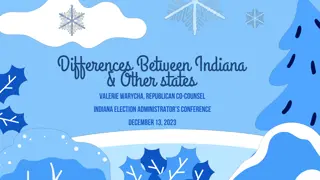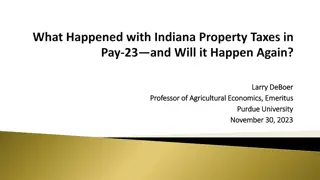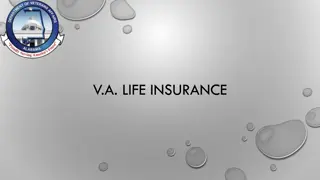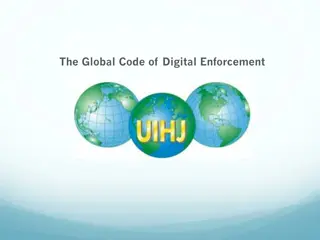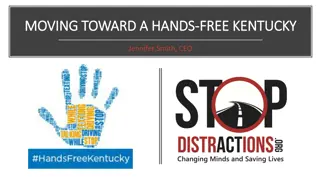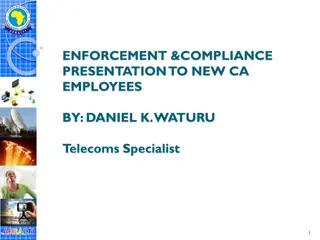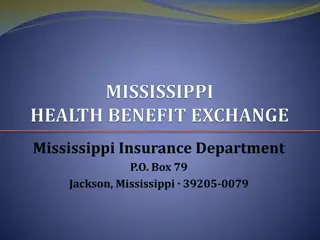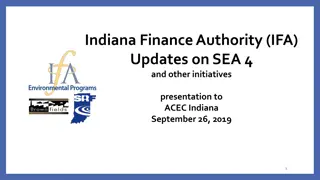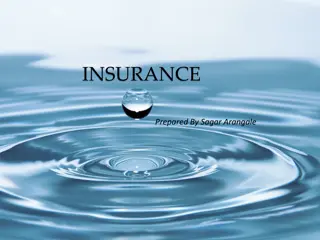Overview of Enforcement Division in Indiana Department of Insurance
The Enforcement Division within the Indiana Department of Insurance regulates a variety of entities and ensures consumer protection in the insurance industry. It covers aspects such as market conduct, consumer services, and producer licensing, aiming to address complaints, improper practices, and legal issues among regulated entities. The division conducts background investigations, manages licensing renewals, and handles enforcement actions to uphold industry standards and protect consumers.
Download Presentation

Please find below an Image/Link to download the presentation.
The content on the website is provided AS IS for your information and personal use only. It may not be sold, licensed, or shared on other websites without obtaining consent from the author. Download presentation by click this link. If you encounter any issues during the download, it is possible that the publisher has removed the file from their server.
E N D
Presentation Transcript
Hot Topics in Enforcement Indiana Department of Insurance Consumer Protection Unit Logo
Presentation Overview Overview of the IDOI Consumer Protection Unit Producer Licensing Technology Advancements: Implications and Regulators
Consumer Protection Unit Consumer Services Division Market Conduct Division Title Division Enforcement Division
Consumer Services Division Resolution of Consumer Complaints Improper Denial or Delay in Settling a Claim (IC 27-4-1-4.5) Illegal Cancellation / Termination of a Policy Matters not Resolved are Referred to Enforcement Public Relations / Consumer Education
Market Conduct Identify Trends or Patterns Associated w/ Company Behavior Consumer Complaints Information or Complaints from other Divisions within IDOI Articles or other Media Sources Initiate a Targeted Market Conduct Examination When Directed Recommendations in Resolving Market Issues Work to Resolve Legal Issues or Inappropriate Market Behavior in lieu of Department Action.
Enforcement Division Entities Regulated by IDOI Bail Bond / Recovery Agents Real Estate Title Agents Independent Adjusters Public Adjusters (Represent the Insured) Consultants Independent and Captive Insurance Producers Company Insurance Producers Third Party Administrators (TPA) Managing General Agents (MGA)
Enforcement Division Entities Regulated by DOI Professional Employer Organizations (PEO) Health Maintenance Organizations (HMO) Discount Medical Card Program Organizations External Review Organizations (ERO) Independent Review Organizations (IRO) Preferred Provider Organizations (PPO) Multiple Employer Welfare Organizations (MEWA)
Enforcement Division Producer Licensing Background Investigations Producer Licensing Renewals / New Applications Producer Applications Adding a New Qualification Criminal History Administrative Actions in other States FINRA (Financial Industry Regulation Authority) Factors Barring an Applicant from Licensure (Disclosed) Felony Domestic Violence Violent Misdemeanor Theft, Embezzlement (Crimes of Dishonesty)
Enforcement Division Factors Barring an Applicant from Licensure Partial Disclosures / Non-Disclosures of Criminal Activity Disciplinary Action from another Jurisdiction (Disclosed / Non-Disclosed) Not more than 30 days after final disposition Termination for Cause FINRA
Enforcement Division Regulatory Oversight of Licensed Producers and Companies Improperly withholding, misappropriating, or converting monies or properties received in the course of doing insurance business. Co-mingling a premium with personal funds Intentional Misrepresentation Coverage of a Policy (Actual or Proposed) Criminal Prosecution (Not more than 30 days after Initial Pretrial Hearing Date) Fraudulent, Coercive, Dishonest Practices, Incompetence, Financial Irresponsibility License denial, suspension, or revocation in another jurisdiction
Enforcement Division Regulatory Oversight of Licensed Producers or Companies Failure to Pay State Income Tax Failure to Comply w/ Court Ordered Child Support Obligation Failing to Timely Inform the Commissioner of a Change in Legal Name or Address Failure to Satisfy Continuing Education Requirements
Technology: A Catalyst for Regulatory Change Can Regulation Keep up with Innovation? Insurance industry historically built on historical data analysis, promises of permanence, and risk control. Change - Various Market Disruptors: Changing Demographic Base w/ Increasingly Sophisticated Consumers Decrease in Brand Loyalty and Trust Socio-economic Trends Demand for Technological Convenience Demand for a Faster, more Efficient, Customer-Friendly Experience Industry Change Driven by Insurtechs
Technology: A Catalyst for Regulatory Change Regulatory Implications Insurtech: Where technological advancement transforms the business of insurance to create simpler products and streamlined customer service, while catering to a more tech-savvy generation of customers. Insurance-on-Demand Usage-based Insurance and Telematics Smart Contracts Blockchains / Distributed Ledger Technology Customer-centric Products and Services It is estimated that there are currently more than 1,500 Insurtech start-ups in more than 60 countries.
Technology: A Catalyst for Regulatory Change Regulatory Implications Insurtechs are active in all lines of business; appear to be primarily concentrated in the property and casualty sector. Legacy companies acquiring technology from Insurtechs and are integrating that technology into their own corporate ecosystems Insurtech concepts will fundamentally alter the business of insurance: Industry Products Data Collection Distribution Channels How Products will be Regulated
Technology: A Catalyst for Regulatory Change Regulatory Implications What must Regulators Consider in Terms of a Industry Change, Technological Advancement, and Consumer Protection? Data Collection and Cybersecurity How is it collected? What are the data sets that will be collected? How will it be used? Who has access to it? How will it be protected?
Technology: A Catalyst for Regulatory Change Regulatory Implications Innovators and entrepreneurs behind initiatives not familiar with regulatory environment in the insurance industry. U.S. based insurance industry is comprised of rules and regulations that may not be consistent from state-to-state. Outdated regulations; effective in the past, but need to be modernized for growing technology. Regulation viewed by the industry as an obstacle where technology is already outrunning regulation.






